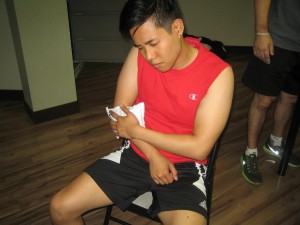For some individuals who engage in running as a sport or for recreation, they might be wondering why ice is used to minimize the inflammation, not heat. Take note that running injuries cause swelling of the tissues, ligaments, muscles and tendons, thus the objective is to minimize these symptoms as soon as possible with ice and heat. With the help of ice, it is a natural method to help reduce the inflammation. As for heat, it will not help the injury at all, especially newly sustained injuries.
Why use ice on running injuries?
The application of ice has always been the recommended treatment for sports-related injuries and it is part of the RICE method (rest, ice, compression and elevation). Aside from reducing the swelling, gentle ice massage can help relax the strained areas. If you want to be prepared to handle soft tissue injuries, all you have to do is to register in a first aid course in your area to learn what the RICE method is all about and its importance in the field of sports.
Regular ice packs can be used but make sure that a damp cloth or towel is placed in between the skin and the ice to avoid frostbite. A bag of frozen vegetables also work since it is light and flexible to ice a particular body part without being bulky.

Injuries sustained on the plantar area on the foot can be iced and massaged at the same time by rolling the foot over a frozen water bottle. In all cases, ice must not be applied for more than 20 minutes at a time.
Why heat is not used?
The application of heat is not suitable for fresh injuries. Take note that it will cause the opposite effect of ice since heat increase the flow of blood, thus aggravating the swelling. On the other hand, heat can be used for tight muscles before exercising. Just avoid using heat after a workout.
Wrapping and rest for running injuries
Aside from ice, other treatment options for running injuries include wrapping and rest. Injuries that involve pain and swelling can greatly benefit from tapes and wraps. As a reaction to an injury, the body will develop an edema close to the damaged tissue that is responsible for the swelling. The rush of fluids will disrupt the healing and limits oxygen to the injured cells. By compressing the area through wrapping, it forces the liquids away from the site of injury to the surrounding tissue. The earlier the compression is done, the better.
Understandably, rest is also an important factor when treating running injuries. Normally, the body heals on its own. In case an individual overexerts, the body does not have time to repair the strained muscles or tissues. As part of the RICE method, rest can involve minimal activity or no exercise which means lessened activity level.
